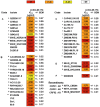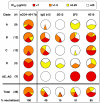sCD4-17b bifunctional protein: extremely broad and potent neutralization of HIV-1 Env pseudotyped viruses from genetically diverse primary isolates
- PMID: 20158904
- PMCID: PMC2843639
- DOI: 10.1186/1742-4690-7-11
sCD4-17b bifunctional protein: extremely broad and potent neutralization of HIV-1 Env pseudotyped viruses from genetically diverse primary isolates
Abstract
Background: We previously described a potent recombinant HIV-1 neutralizing protein, sCD4-17b, composed of soluble CD4 attached via a flexible polypeptide linker to an SCFv of the 17b human monoclonal antibody directed against the highly conserved CD4-induced bridging sheet of gp120 involved in coreceptor binding. The sCD4 moiety of the bifunctional protein binds to gp120 on free virions, thereby enabling the 17b SCFv moiety to bind and block the gp120/coreceptor interaction required for entry. The previous studies using the MAGI-CCR5 assay system indicated that sCD4-17b (in concentrated cell culture medium, or partially purified) potently neutralized several genetically diverse HIIV-1 primary isolates; however, at the concentrations tested it was ineffective against several other strains despite the conservation of binding sites for both CD4 and 17b. To address this puzzle, we designed variants of sCD4-17b with different linker lengths, and tested the neutralizing activities of the immunoaffinity purified proteins over a broader concentration range against a large number of genetically diverse HIV-1 primary isolates, using the TZM-bl Env pseudotype assay system. We also examined the sCD4-17b sensitivities of isogenic viruses generated from different producer cell types.
Results: We observed that immunoaffinity purified sCD4-17b effectively neutralized HIV-1 pseudotypes, including those from HIV-1 isolates previously found to be relatively insensitive in the MAGI-CCR5 assay. The potencies were equivalent for the original construct and a variant with a longer linker, as observed with both pseudotype particles and infectious virions; by contrast, a construct with a linker too short to enable simultaneous binding of the sCD4 and 17b SCFv moieties was much less effective. sCD4-17b displayed potent neutralizing activity against 100% of nearly 4 dozen HIV-1 primary isolates from diverse genetic subtypes (clades A, B, C, D, F, and circulating recombinant forms AE and AG). The neutralization breadth and potency were superior to what have been reported for the broadly neutralizing monoclonal antibodies IgG b12, 2G12, 2F5, and 4E10. The activity of sCD4-17b was found to be similar against isogenic virus particles from infectious molecular clones derived either directly from the transfected producer cell line or after a single passage through PBMCs; this contrasted with the monoclonal antibodies, which were less potent against the PMBC-passaged viruses.
Conclusions: The results highlight the extremely potent and broad neutralizing activity of sCD4-17b against genetically diverse HIV-1 primary isolates. The bifunctional protein has potential applications for antiviral approaches to combat HIV infection.
Figures





Similar articles
-
Neutralization of human immunodeficiency virus type 1 by sCD4-17b, a single-chain chimeric protein, based on sequential interaction of gp120 with CD4 and coreceptor.J Virol. 2003 Mar;77(5):2859-65. doi: 10.1128/jvi.77.5.2859-2865.2003. J Virol. 2003. PMID: 12584309 Free PMC article.
-
Novel CD4-Based Bispecific Chimeric Antigen Receptor Designed for Enhanced Anti-HIV Potency and Absence of HIV Entry Receptor Activity.J Virol. 2015 Jul;89(13):6685-94. doi: 10.1128/JVI.00474-15. Epub 2015 Apr 15. J Virol. 2015. PMID: 25878112 Free PMC article.
-
Identification and characterization of a new cross-reactive human immunodeficiency virus type 1-neutralizing human monoclonal antibody.J Virol. 2004 Sep;78(17):9233-42. doi: 10.1128/JVI.78.17.9233-9242.2004. J Virol. 2004. PMID: 15308718 Free PMC article.
-
Novel approaches for identification of broadly cross-reactive HIV-1 neutralizing human monoclonal antibodies and improvement of their potency.Curr Pharm Des. 2007;13(2):203-12. doi: 10.2174/138161207779313669. Curr Pharm Des. 2007. PMID: 17269928 Review.
-
Human monoclonal antibodies and engineered antibody domains as HIV-1 entry inhibitors.Curr Opin HIV AIDS. 2009 Mar;4(2):112-7. doi: 10.1097/COH.0b013e328322f95e. Curr Opin HIV AIDS. 2009. PMID: 19339949 Free PMC article. Review.
Cited by
-
Extracellular domain, hinge, and transmembrane determinants affecting surface CD4 expression of a novel anti-HIV chimeric antigen receptor (CAR) construct.PLoS One. 2024 Aug 12;19(8):e0293990. doi: 10.1371/journal.pone.0293990. eCollection 2024. PLoS One. 2024. PMID: 39133676 Free PMC article.
-
Bifunctional CD4-DC-SIGN fusion proteins demonstrate enhanced avidity to gp120 and inhibit HIV-1 infection and dissemination.Antimicrob Agents Chemother. 2012 Sep;56(9):4640-9. doi: 10.1128/AAC.00623-12. Epub 2012 Jun 11. Antimicrob Agents Chemother. 2012. PMID: 22687513 Free PMC article.
-
Further Characterization of the Bifunctional HIV Entry Inhibitor sCD4-FIT45.Mol Ther Nucleic Acids. 2017 Jun 16;7:387-395. doi: 10.1016/j.omtn.2017.04.017. Epub 2017 Apr 22. Mol Ther Nucleic Acids. 2017. PMID: 28624214 Free PMC article.
-
Extracellular domain, hinge, and transmembrane determinants affecting surface CD4 expression of a novel anti-HIV chimeric antigen receptor (CAR) construct.bioRxiv [Preprint]. 2023 Oct 26:2023.10.25.563930. doi: 10.1101/2023.10.25.563930. bioRxiv. 2023. Update in: PLoS One. 2024 Aug 12;19(8):e0293990. doi: 10.1371/journal.pone.0293990. PMID: 37961145 Free PMC article. Updated. Preprint.
-
A general approach for receptor and antibody-targeted detection of native proteins utilizing split-luciferase reassembly.ACS Chem Biol. 2010 Oct 15;5(10):943-52. doi: 10.1021/cb100143m. ACS Chem Biol. 2010. PMID: 20681584 Free PMC article.
References
-
- Alkhatib G, Berger EA. HIV coreceptors: from discovery and designation to new paradigms and promise. Eur J Med Res. 2007;12:375–384. - PubMed
Publication types
MeSH terms
Substances
Grants and funding
LinkOut - more resources
Full Text Sources
Other Literature Sources
Medical
Research Materials

